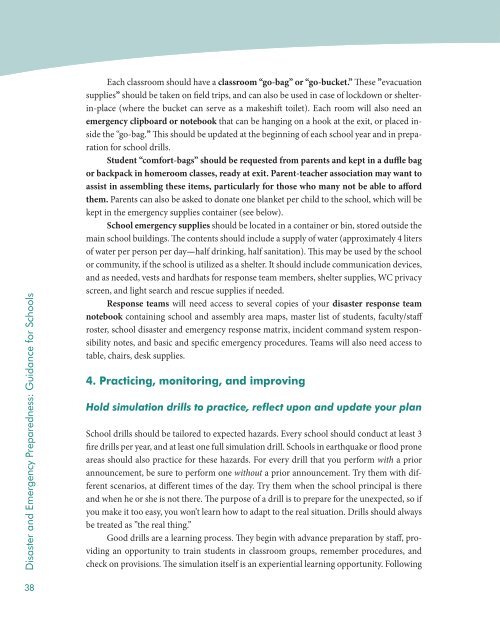Disaster and Emergency Preparedness: Guidance for ... - INEE Toolkit
Disaster and Emergency Preparedness: Guidance for ... - INEE Toolkit
Disaster and Emergency Preparedness: Guidance for ... - INEE Toolkit
You also want an ePaper? Increase the reach of your titles
YUMPU automatically turns print PDFs into web optimized ePapers that Google loves.
<strong>Disaster</strong> <strong>and</strong> <strong>Emergency</strong> <strong>Preparedness</strong>: <strong>Guidance</strong> <strong>for</strong> SchoolsEach classroom should have a classroom “go-bag” or “go-bucket.” These ”evacuationsupplies” should be taken on field trips, <strong>and</strong> can also be used in case of lockdown or shelterin-place(where the bucket can serve as a makeshift toilet). Each room will also need anemergency clipboard or notebook that can be hanging on a hook at the exit, or placed insidethe “go-bag.” This should be updated at the beginning of each school year <strong>and</strong> in preparation<strong>for</strong> school drills.Student “com<strong>for</strong>t-bags” should be requested from parents <strong>and</strong> kept in a duffle bagor backpack in homeroom classes, ready at exit. Parent-teacher association may want toassist in assembling these items, particularly <strong>for</strong> those who many not be able to af<strong>for</strong>dthem. Parents can also be asked to donate one blanket per child to the school, which will bekept in the emergency supplies container (see below).School emergency supplies should be located in a container or bin, stored outside themain school buildings. The contents should include a supply of water (approximately 4 litersof water per person per day—half drinking, half sanitation). This may be used by the schoolor community, if the school is utilized as a shelter. It should include communication devices,<strong>and</strong> as needed, vests <strong>and</strong> hardhats <strong>for</strong> response team members, shelter supplies, WC privacyscreen, <strong>and</strong> light search <strong>and</strong> rescue supplies if needed.Response teams will need access to several copies of your disaster response teamnotebook containing school <strong>and</strong> assembly area maps, master list of students, faculty/staffroster, school disaster <strong>and</strong> emergency response matrix, incident comm<strong>and</strong> system responsibilitynotes, <strong>and</strong> basic <strong>and</strong> specific emergency procedures. Teams will also need access totable, chairs, desk supplies.4. Practicing, monitoring, <strong>and</strong> improvingHold simulation drills to practice, reflect upon <strong>and</strong> update your planSchool drills should be tailored to expected hazards. Every school should conduct at least 3fire drills per year, <strong>and</strong> at least one full simulation drill. Schools in earthquake or flood proneareas should also practice <strong>for</strong> these hazards. For every drill that you per<strong>for</strong>m with a priorannouncement, be sure to per<strong>for</strong>m one without a prior announcement. Try them with differentscenarios, at different times of the day. Try them when the school principal is there<strong>and</strong> when he or she is not there. The purpose of a drill is to prepare <strong>for</strong> the unexpected, so ifyou make it too easy, you won’t learn how to adapt to the real situation. Drills should alwaysbe treated as ”the real thing.”Good drills are a learning process. They begin with advance preparation by staff, providingan opportunity to train students in classroom groups, remember procedures, <strong>and</strong>check on provisions. The simulation itself is an experiential learning opportunity. Following38
















